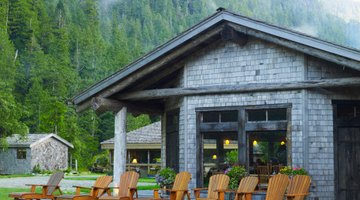Advantages & Disadvantages of Post & Beam Construction
Post and beam construction utilizes large vertical wood beams that are placed about 8 feet apart and a series of horizontal beams placed across them to support either a second floor or a roof.

In contrast with light wood framing, which became popular in the mid-19th century in the United States, post and beam houses feature a relatively small number of larger, heavier structural components.
Pro: Structural Advantages
Because the weight of the structure is supported by posts that are spaced relatively far apart, post and beam construction allows for large expanses of glass. Consequently, post and beam houses often feature large windows. Furthermore, post and beam houses usually feature high vaulted ceilings, creating a large, roomy living space.
Pro: Fire Resistance
Because the timber used in constructing a post and beam structure must be denser and stronger than in light frame buildings (post and beam wood is typically Type IV grade), it is more fire resistant. Light frame buildings are often built from softwood, which is less dense and more porous, making them more susceptible to fire.
Con: Cost
As opposed to light frame construction, building a post and beam home requires large pieces of high quality timber cut from large trees. Moreover, these heavy pieces of wood must be moved into place using some kind of crane, whereas light frame construction can be assembled from a large quantity of light pieces.
In addition, because post and beam construction relies on a fewer number of structural elements, their placement must be more precise. This expertise is often difficult to come by and, therefore, is expensive.
Con: Susceptibility to Rotting
Another disadvantage of post and beam buildings is their susceptibility to rotting. Often beams are on the outside of the home and are not covered. This exposure allows the beams, which are essential structural elements, to rot over long periods of time.
Furthermore, the large amounts of exposed wood on the exterior of the house are more susceptible to infestation by a variety of harmful pests, especially termites and carpenter ants.
The Drip Cap
- Post and beam construction utilizes large vertical wood beams that are placed about 8 feet apart and a series of horizontal beams placed across them to support either a second floor or a roof.
- In contrast with light wood framing, which became popular in the mid-19th century in the United States, post and beam houses feature a relatively small number of larger, heavier structural components.
- Light frame buildings are often built from softwood, which is less dense and more porous, making them more susceptible to fire.
References
Writer Bio
Patrick Stothers Kwak first began writing professionally in 2008 as a contributor to the "UBC Foreign Affairs Journal." His articles are centered around international politics and political economy. Stothers Kwak holds a Bachelor of Arts in international relations from the University of British Columbia and is pursuing his Juris Doctorate at Osgoode Hall Law School at York University.
Photo Credits
- Ryan McVay/Lifesize/Getty Images
- Ryan McVay/Lifesize/Getty Images
More Articles



